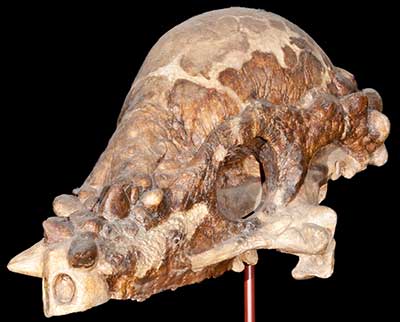Pachycephalosaurus
(PAK-ee-kef-AH-loh-SAW-rus)
| Quick Facts | |
|---|---|
| Name Meaning: | Thick Headed Lizard |
| Distribution: | North America (Montana, South Dakota, Wyoming) |
| Time Period: | Late Cretaceous, 75 Ma - 65 Ma |
| Length: | 15 ft (4.5 m) |
| Height: | 17.5 ft (4.3 m) |
| Weight: | 1 ton |
| Diet: | Herbivore or Omnivore |
| Linnaean Classification | |
| Kingdom: | Animalia |
| Phylum: | Chordata |
| Class: | Reptilia |
| Superorder: | Dinosauria |
| Order: | Ornithischia |
| Suborder: | Pachycephalosauria |
| Family: | Pachycephalosauridae |
| Genus: | Pachycephalosaurus |
| Cladistic Classification | |
| |

History
Not much is known about the Pachycephalosaurus because only a single nearly-complete skull has been uncovered along with a few thick skull roofs. It would have been one of the last dinosaurs to live on the earth before the great extinction. Small remains have been found since the 1850s. In 1859 Ferdinand Vandiveer discovered a small bone fragment at the head of the Missouri river in Montana. It was described as armor from some reptile or armadillo-like creature. The species was named in 1931 by Charles Gilmore from a partial skull. Of that species, Pachycephalosaurus is the only known genus. In 1943 a nearly complete skull was discovered in the Hell Creek Formation in Montana, and the genus was official defined by Barnum Brown and Erich Maren Schlaikjer.Description
The Pachycephalosaurus had a huge skull plate, providing cushion for its small brain. The plate was surrounded by small blunt spikes. It had a small muzzle with a pointed beak and tiny teeth. Its head was either supported by a S- or U-shaped neck. Its eyes were large and could have used binocular vision giving it a great advantage. If it was like other pachycephalosaurids it had long legs and small arms, probably bipedal, and carried a long tail held rigid with tendons that slowly solidified with time to turn to bone. It would have been the largest known Pachycephalosaur.Lifestyle
For a long time paleontologists thought that the thick skull was used for combat and competition, lowering its head, straightening the neck to become rigid, and headbutting others of its kind. Recent study has shown that this is probably not the case. First, no scars or other evidence of severe damage have been found in the skulls. Also, the head was probably supported by an S- or U-shaped neck making it impossible to straighten the spine. It may have been used as a display or used to flank the other competitor and strike them from the side. With its small teeth it could not have eaten large tough plant material and may have feasted on small leaves, fruits, or insects.
ScienceViews Writer: Jason Hamilton.
Copyright © 2005-2010 Calvin & Rosanna Hamilton. All rights reserved.